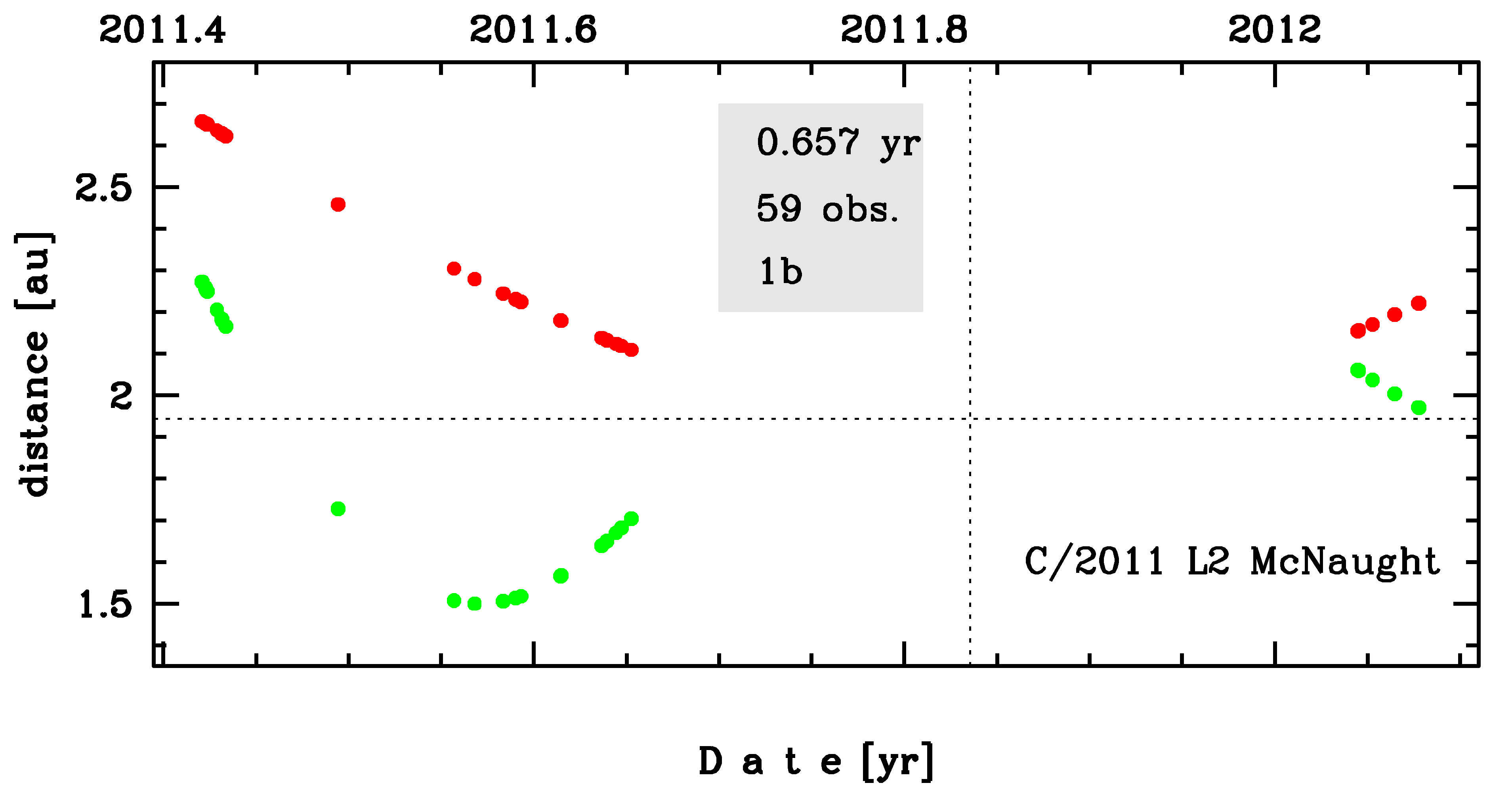C/2011 L2 McNaught
more info
Comet C/2011 L2 was discovered on 2 June 2011 by Robert H. McNaught (Siding Spring); that is about 5 months before its perihelion passage. The comet was observed until 28 January 2012.
Comet had its closest approach to the Earth on 27 July 2011 (1.500 au), almost 2 months after discovery and about 3 months before its perihelion passage.
Solutions given here are based on data spanning over 0.657 yr in a range of heliocentric distances: 2.66 au – 1.943 au (perihelion) – 2.22 au. The non-gravitational solution was chosen as preferred orbit; however, uncertainties of NG parameters are large.
This Oort spike comet suffers small planetary perturbations during its passage through the planetary system; these perturbations lead to a more tight future orbit (see future barycentric orbits).
See also Królikowska 2020.
Comet had its closest approach to the Earth on 27 July 2011 (1.500 au), almost 2 months after discovery and about 3 months before its perihelion passage.
Solutions given here are based on data spanning over 0.657 yr in a range of heliocentric distances: 2.66 au – 1.943 au (perihelion) – 2.22 au. The non-gravitational solution was chosen as preferred orbit; however, uncertainties of NG parameters are large.
This Oort spike comet suffers small planetary perturbations during its passage through the planetary system; these perturbations lead to a more tight future orbit (see future barycentric orbits).
See also Królikowska 2020.
| solution description | ||
|---|---|---|
| number of observations | 59 | |
| data interval | 2011 06 02 – 2012 01 28 | |
| data type | perihelion within the observation arc (FULL) | |
| data arc selection | entire data set (STD) | |
| range of heliocentric distances | 2.66 au – 1.94 au (perihelion) – 2.22 au | |
| type of model of motion | NS - non-gravitational orbits for standard g(r) | |
| data weighting | NO | |
| number of residuals | 107 | |
| RMS [arcseconds] | 0.41 | |
| orbit quality class | 1b | |
| previous orbit statistics, both Galactic and stellar perturbations were taken into account | ||
|---|---|---|
| no. of returning VCs in the swarm | 1592 | |
| no. of escaping VCs in the swarm | 3409 | * |
| no. of hyperbolas among escaping VCs in the swarm | 1855 | |
| previous reciprocal semi-major axis [10-6 au-1] | -21.92 – 7.48 – 37.14 | |
| previous perihelion distance [au] | 110 – 520 – 800 | R |
| previous aphelion distance [103 au] | 47 – 110 – 520 | |
| time interval to previous perihelion [Myr] | 2.8 – 6.2 – 12 | R |
| percentage of VCs with qprev < 10 | 7 | |
| percentage of VCs with qprev > 20 | 93 | |
| previous_g orbit statistics, here only the Galactic tide has been included | ||
|---|---|---|
| no. of returning VCs in the swarm | 1731 | |
| no. of escaping VCs in the swarm | 3270 | * |
| no. of hyperbolas among escaping VCs in the swarm | 1849 | |
| previous reciprocal semi-major axis [10-6 au-1] | -21.78 – 7.56 – 37.18 | |
| previous perihelion distance [au] | 1.9 – 16 – 310 | R |
| previous aphelion distance [103 au] | 47 – 110 – 510 | |
| time interval to previous perihelion [Myr] | 2.9 – 6.2 – 12 | R |
| percentage of VCs with qprev < 10 | 43 | |
| percentage of VCs with 10 < qprev < 20 | 11 | |
| percentage of VCs with qprev > 20 | 46 | |
